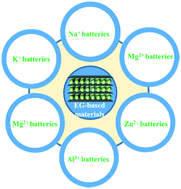Application of expanded graphite-based materials for rechargeable batteries beyond lithium-ions
Abstract
New types of rechargeable batteries other than lithium-ions, including sodium/potassium/zinc/magnesium/calcium/aluminum-ion batteries and non-aqueous batteries, are rapidly advancing towards large-scale energy storage applications. A major challenge for these burgeoning batteries is the absence of appropriate electrode materials, which gravely hinders their further development. Expanded graphite (EG)-based electrode materials have been proposed for these emerging batteries due to their low cost, non-toxic, rich-layered structure and adjustable layer spacing. Here, we evaluate and summarize the application of EG-based materials in rechargeable batteries other than Li+ batteries, including alkaline ion (such as Na+, K+) storage and multivalent ion (such as Mg2+, Zn2+, Ca2+ and Al3+) storage batteries. Particularly, this article discusses the composite strategy and performance of EG-based materials, which enables them to function as an electrode in these emerging batteries. Future research areas in EG-based materials, from the fundamental understanding of material design and processing to reaction mechanisms and device performance optimization strategies, are being looked forward to.

- This article is part of the themed collections: Recent Review Articles and 2021 Nanoscale HOT Article Collection


 Please wait while we load your content...
Please wait while we load your content...